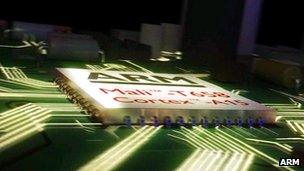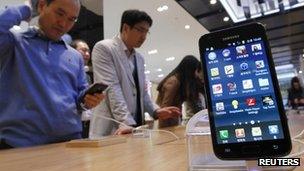ARM's new GPU chip design aims to boost mobile graphics
- Published

ARM says its next generation GPU may start appearing in devices towards the end of 2013
British computer chip designer ARM has unveiled its latest graphics processing unit (GPU) for mobile devices.
The Mali-T658 offers up to ten times the performance of its predecessor.
It paves the way for faster games and other more complex software on smartphones and tablet computers.
ARM hopes to expand its share of a rapidly-growing market. Demand for its mobile GPU designs lags behind that for its central processing units (CPUs).
The most high-profile use of its GPU to date is in Samsung's award winning Galaxy 2 handsets. They use chips based on the T658's older brother, the Mali-400 MP.
A review in September by the influential website AnandTech <link> <caption>rated the 400 MP the fastest GPU</caption> <url href="http://www.anandtech.com/show/4760/arms-mali400-mp4-is-the-fastest-smartphone-gpufor-now" platform="highweb"/> </link> available in a smartphone. It has since been overtaken by a rival's design used in the latest iPhone.
ARM says manufacturers are likely to have its new design in use in around two years.
"It all comes down to user experience," said Jem Davies at ARM's Media Processing Division.
"Faster graphics performance with snappier, more responsive user interfaces, more immersive game play and a whole range of new applications which are being enabled by the capabilities of GPU computing."
Calculations
GPU cores offer specialised processing capabilities that bolster the power of the main CPU.
A GPU's key function is to take all the polygon co-ordinates described by a piece of graphics software and work out how to draw, colour and shade them. It then uses this information to determine what colour each pixel of the screen should be as the image changes dozens of times every second.

Samsung's Galaxy S2 smartphone uses a previous ARM-based graphics processing unit
The more powerful the GPU, the more detail is possible. Top of the range games can require millions of polygons on screen at the same time to create 3D-like environments.
To maximise performance, manufacturers can link several GPUs together.
ARM's previous design allowed up to four cores to be connected.
The Mali-T658 doubles the maximum to eight, with each core offering double the arithmetic capability of its forerunner.
"It's all about power," said Mr Davies.
"The idea is that when the full performance is required, you power up all of those cores. But having a multi-core architecture means that when the performance needs are lower, we can power some of those cores down."
This allows ARM to play to one of its strengths - its reputation for lower energy consumption.
Console quality graphics
The firm claims the new technology will offer battery-powered mobile handsets roughly the same graphics performance as Sony's PlayStation 3 console.
However, its rival Imagination Technologies has made similar assertions about its upcoming PowerVR designs. Like ARM, the firm is headquartered in the UK. Its current architecture is used by Apple in its iPhone and iPad products.
California-based NVIDIA and Qualcomm also talk up their GeForce and Adreno technologies.
But whatever the firms' claims, customer expectations are hard to beat.
"You have cinema, you have high definition, you have hugely complex CGI movies on HD screens in your lounge," said Ian Smythe, director of marketing at ARM's Media Processing division.
"You expect this high quality experience from every screen that you look at. And so the user experience has to be of that sort of quality.
"Reproducing a CGI movie - which is generated on a server farm where it takes a day to render a frame with 50,000 processors - being able to reproduce that in a mobile experience is clearly a challenge."
Speech recognition
GPUs are particularly good at what are termed "parallelisable" tasks - processes that can be broken down into several parts and run simultaneously because the outcome of any one calculation does not determine the input of another.
This is particularly suited for applications offering augmented reality, allowing users to overlay graphical information over live images of whatever their devices' cameras are facing.
Other potential uses include image processing, pattern matching and speech recognition.
Competition among the GPU designers is helping drive computing power to new heights, making possible processes unthinkable on previous generations of handsets.
However, developers need to code their software to take advantage of the graphics processors if they are to make the most of the accelerated performance on offer.
That is a challenge when different devices use different designs.
"At the moment many of the speech recognition applications that are out there are solely relying on the CPU," said Mr Davies.
"Very few are taking advantage of the acceleration of the GPU - and that's clearly an area of growth for us."
- Published1 November 2011
- Published25 October 2011
- Published19 October 2011
- Published6 January 2011